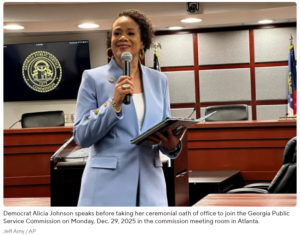NORTH CAROLINA: Kids Civil War Camp a Hit
DALLAS, N.C. — In the small Gaston County town of Dallas, kids between the ages of 8 and 12 recently walked up to men in blue and gray uniforms, took a feather, dipped it in fake ink, and picked which side of the Civil War they wanted to fight for. It was part of a day-long Civil War soldier camp at the Gaston County Museum. The camp has a simple mission: to fairly represent both sides of the Civil War, and to teach children the defining role that slavery played in it.

A small group of 8- to 12-year-olds learn about how soldiers trained for the Civil War.
Michael Tomsic
Across the street from the courthouse where Gaston County residents signed up to fight in the Civil War 150 years ago, Jason Luker stands in a gray Confederate uniform at the Gaston County museum. He’s waiting to greet children and tape a name to their backs.
“I’m going to put a name on your back, and you have to go around and see if you can find out who is on your back by asking questions like, did he fight for the Confederacy, did he fight for the Union?” Luker said.
It’s the first lesson of the day for the 15 boys who are here. They’re between 8 and 12 years old, and they spend the next 15 minutes or so figuring out if they’re Stonewall Jackson, Ulysses Grant or other generals and politicians.
Most of the kids say they’re here for the same reasons: to learn about the war and have fun. The camp delivers over the course of five hours.
Will Ruark, dressed in a blue Union uniform, leads them through marches and teaches them about soldiers’ training.
“Before breakfast, you would march,” he said. “You would eat breakfast. You would march. You would have lunch. You would march. You would have dinner. And guess what you did after dinner?”
The kids murmur, “March.”
“You would march some more!” Ruark said with a laugh.
He and two other adults also demonstrate how to fire 1860s-era guns, and the kids go through the motions with fake, wooden rifles taller than they are.
Luker shows the kids a slideshow in the museum about the major generals in the Civil War.
“Sherman, anyone know anything about Sherman?” Luker asked.
“He burned a path straight through Georgia and destroyed like half of it,” said 12-year-old Luke Richardson.
He and the other boys get to choose which side they fight for in a mock battle at the end of the day.
Will Ruark makes the case for the Union.
“We need to preserve the United States of America,” Ruark said.
Museum volunteer Jay England argues for the Confederacy. (England takes part in reenactments as a Confederate soldier throughout the Southeast.)
“We are fighting to preserve our rights here in the South,” he said. “We do not want a central government telling us what we can and can’t do.”
Neither Ruark nor England mentions slavery. But as soon as they finish, 9-year-old Ben Villamore makes his own argument.
“They shouldn’t have slaves because this is a free country,” he said.
The adult leading the camp, Luker, thanks Villamore for bringing that up.
“The big dividing point – what’s separating the North and the South – is slavery,” he said. “It’s at the heart of this struggle.”
And then he asks, what is slavery? A boy raised his hand.
“Slavery is a thing like, because back then black and white people didn’t get along,” the boy said, “so some of the Confederate, or Union people, held slaves…”
Luker cuts in to say before we break it down by sides, let’s define slavery. A few more kids chime in.
“Someone who works for other people for no money and are beaten if they’re not doing their work,” one boy said.
“It’s someone who’s held against their will to work,” another boy offered.
Luker said what’s missing is the word “property.” He said slaves were people who were black who had no rights – white people owned them. And he said there’s a reason the adult making the case for the Confederacy didn’t mention slaves.
“Majority of the people who lived here did not own slaves,” he said. “Only 20 percent of the people in this area owned slaves. And the people who did own slaves, only about 10 percent of those people owned more than 10 slaves.”
Luker said although it was the major dividing point between North and South, some Confederate soldiers didn’t see themselves as fighting to preserve slavery – they were fighting for states’ rights.
After learning more about slave states and free states, the 8- to 12-year-olds line up to pick a side.
They use a feather to sign their names, and they split pretty evenly between the Confederacy and the Union.
Ben Villamore chooses the Union.
“Because I think, since they say it’s a free country, even the slaves should be free,” he said.
And Luke Richardson chooses the Confederacy.
“I just like fighting for my state,” he said.
Richardson also has family members who fought for the Confederacy. That’s a common reason kids choose that side, said museum outreach coordinator Kelly Mason, who’s worked these camps about five years.
“I found that a lot of people from the South love their heritage, their ancestors, the stories that get passed down,” she said.
Whereas kids who want to fight for the Union, “they love the ideas of the North – we want to fight for freedom, this is a country for free people,” Mason said.
And keep in mind, she said, they’re just kids. Once the mock battle starts, it’s easy to remember.
The 15 boys squeal, laugh and yell as they square off with water balloons. The battle ends with the two sides lining up and belting each other (including Ruark and Luker) with water balloons. Everyone gets soaked – there’s no clear winner.
Afterward, Luker thanks parents for bringing their kids.
“All the kids were fantastic,” he said. “They were very engaged, asked wonderful questions, and it was a pleasure to be with them.”
There were no African-Americans at the camp, but that doesn’t take away from Stacey Malker Duff’s appreciation of it. She’s the first African-American woman elected to the town of Dallas’ Board of Alderman.
“I faced a lot of stuff knocking on doors – it was not all pretty,” she said.
Malker Duff said some people made racist comments to her as she campaigned last year. But she said that’s nothing compared to what her ancestors went through, and it’s important for children to learn that history.
“Our children need to see from whence we came, and the growth we’ve made,” she said. “And we still have a ways to go.”
Several of the parents echo those ideas. Jennifer Villamore is Ben’s mom, the kid who pointed out this is a free country.
“We want him to know about his ancestors,” she said. “We want him to know about his current family members. My brother-in-law, my nephew are both serving in the army, and so he’s got that on his heart to serve his country later.”
Another parent, Tim Richardson, brought his sons Luke and Levi.
“It’s so hard for them to conceptualize slavery and what that means,” he said. “Luke kind of gets it but Levi really doesn’t. I have to constantly re-explain what that was and why.”
Luke, the 12-year-old who signed up for the Confederacy, puts it simply:
“I don’t approve of slavery,” he said. “It’s just an evil thing.”
The idea that inequality is evil was a radical notion before the Civil War, said Jason Luker, the camp’s leader.
“And we want to be able to show them – where did you get those ideas?” he said. “It came from this major, bloody moment in our history.”
Luker said if every kid leaves with a desire to learn more about the Civil War, that’s his dream for the camp.
Governor Terry McAuliffe announced today that ABC Signature, a division of ABC Studios, has chosen Virginia for Point of Honor, the pilot for the television series ABC is co-producing with Amazon Studios. The original series is a historical drama about a Virginia family whose lives are torn apart by the Civil War. Filming will take place in September around central Virginia and streaming episodes will be part of the Amazon prime service, which provides original filmed content to members.
Director Randall Wallace, who graduated from E.C. Glass High School in Lynchburg and went on to direct the 2010 film Secretariat about Virginia’s legendary triple-crown winning thoroughbred, will helm the project. Wallace is also known for his screenplay for Braveheart and most recently wrote and directed the touching film Heaven is for Real. Point of Honor is co-written and produced by Carlton Cuse, executive producer for the hit series Lost, for which he won an Emmy, a Golden Globe, a Producer’s Guild Award and a Writer’s Guild Award.
Governor McAuliffe commented, “I am proud to welcome ABC and Amazon to Virginia to film Point of Honor. Once again the Commonwealth will serve as the perfect palette to tell the story of this important part of American history. We appreciate the opportunity to welcome Randall Wallace home to Virginia.”
“Bringing Point of Honor to Virginia is another success for the state’s film industry” said Maurice Jones, Virginia Secretary of Commerce and Trade. “Projects such as this are instrumental in expanding the infrastructure required to promote a strong and vital production business environment, thus continuing to diversify our economy and create jobs.”
Randall Wallace commented, “We are immensely impressed with the welcome we have received from Governor McAuliffe, the Virginia Film Office and the support from everyone we’ve met in Virginia.”
Virginia Film Office Director Andy Edmunds noted, “We have been working with Randall Wallace since he came to Virginia to research for Secretariat. A lack of competitive film incentives at the time prevented him from being able to film that legendary Virginia story in Virginia. I couldn’t be happier that we are finally able to bring Randall back to his home state for a ground-breaking new media project such as this one. The economic impact for Virginia should it become a series will be significant.”
Point of Honor will be eligible for a film tax credit and funding from the Governor’s Motion Picture Opportunity Fund. The exact amount will be based on how much money the production spends within the state, and certain deliverables to promote tourism in Virginia.
In 2012 the economic impact of the film and television industry in Virginia totaled $328.4 million and provided 3,061 jobs with $50.5 million in tax revenue.
–fairfaxnews.com
###



